

6 minutes pour comprendre la biodiversité. YouTube. Biodiversité : 7 chiffres alarmants sur la disparition des espèces. Office Français de la Biodiversité. Tio2 nanoparticles toxicity - Google Scholar. Titanium dioxide in food - United States Patent and Trademark Office Search Results. Skip to main content Search results CPC Scheme - A23V INDEXING SCHEME RELATING TO FOODS, FOODSTUFFS OR NON-ALCOHOLIC BEVERAGES CLASSIFICATION A23V INDEXING SCHEME RELATING TO FOODS, FOODSTUFFS OR NON-ALCOHOLIC BEVERAGES...2002/00 Food compositions, function of food ingredients ...
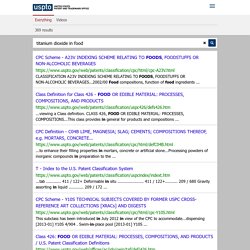
Class Definition for Class 426 - FOOD OR EDIBLE MATERIAL: PROCESSES, COMPOSITIONS, AND PRODUCTS ...viewing a Class definition. CPC Definition - C04B LIME, MAGNESIA; SLAG; CEMENTS; COMPOSITIONS THEREOF, e.g. ...to enhance their filling properties in mortars, concrete or artificial stone...Processing powders of inorganic compounds in preparation to the ... T - Index to the U.S. ...tab ............ 411 / 122+ Deformable in situ ..................... 411 / 122+.......... 209 / 680 Gravity assorting in liquid ............ 209 / 172 ... CPC Scheme - Y10S TECHNICAL SUBJECTS COVERED BY FORMER USPC CROSS-REFERENCE ART COLLECTIONS [XRACs] AND DIGESTS ORGANOLEPTIC MATERIAL, ETC.) 102 .
USPC Consolidated Glossary Note. Titanium dioxide in our everyday life; is it safe? Impact du colorant alimentaire E171 et de nanoparticules de dioxyde de titane sur des modèles cellulaires, in vitro, d'épithélium intestinal. Abstract : Micro-sized titanium dioxide (TiO2) particles are used for years by industrials for their attractive physical and chemical properties.
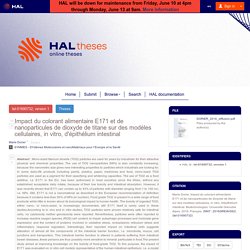
The use of TiO2 nanoparticles (NPs) is also constantly increasing, because the nanometric size gives new interesting properties to particles which industrials are looking for. In some daily-life products including paints, plastics, paper, medicines and food, micro-sized TiO2 particles are used as a pigment for their opacifying and whitening capacities. The use of TiO2 as a food additive, i.e. E171 in the EU, has been authorized in most countries since the 60ies, without any established acceptable daily intake, because of their low toxicity and intestinal absorption. However, it was recently shown that E171 can contain up to 43% of particles with diameter ranging from 1 to 100 nm, i.e. Titanium dioxide. /LABORATORY ANIMALS: Acute Exposure/ The toxicity of titanium dioxide was studied in rats.
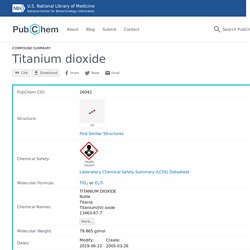
Male Wistar rats were exposed to titanium dioxide intratracheally at 25 or 50 mg once and controls received saline only. Three months after exposure, rats were killed; lungs, mediastinal and axillary lymphatic nodes and spleen were excised for histological and histochemical examination. Rats exposed to the chemical at 50 mg showed extensive deposition of the metal oxide in respiratory epithelium and in the lumen of alveoli. Major bronchioles contained very little chemical deposition. Eosinophilic infiltration was also seen. Impact of food grade and nano-TiO2 particles on a human intestinal community. Bachler et al., 2015 G. Bachler, N. von Goetz, K. Dioxyde de Titane, est-il dangereux pour votre Peau ... Evaluation of four new studies on the potential toxicity of titanium. Association of Type 2 Diabetes with Submicron Titanium Dioxide Crystals in the Pancreas. Long-Term Pulmonary Responses of Three Laboratory Rodent Species to Subchronic Inhalation of Pigmentary Titanium Dioxide Particles Bermudez, Edilberto; Mangum, James B.; Asgharian, Bahman; Wong, Brian A.; Reverdy, Edward E.; Janszen, Derek B.; Hext, Paul M.; Warheit, David B.; Everitt, Jeffrey I.

Food additive E171: First findings of oral exposure to titanium dioxide nanoparticles. Researchers from INRA and their partners1 have studied the effects of oral exposure to titanium dioxide, an additive (E171) commonly used in foodstuffs, especially confectionary.
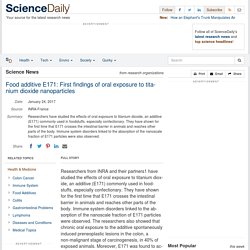
They have shown for the first time that E171 crosses the intestinal barrier in animals and reaches other parts of the body. Immune system disorders linked to the absorption of the nanoscale fraction of E171 particles were observed. The researchers also showed that chronic oral exposure to the additive spontaneously induced preneoplastic lesions in the colon, a non-malignant stage of carcinogenesis, in 40% of exposed animals. Moreover, E171 was found to accelerate the development of lesions previously induced for experimental purposes. While the findings show that the additive plays a role in initiating and promoting the early stages of colorectal carcinogenesis, they cannot be extrapolated to humans or more advanced stages of the disease. Toxicological impact of acute exposure to E171 food ... Titanium dioxide in nanoparticle form: ANSES defines a toxicity reference value (TRV) for chronic inhalation exposure.
The news has been added to your library News of 02/04/2019 Titanium dioxide in nanoparticle form (TiO2-NP) is used in many industrial and commercial applications.
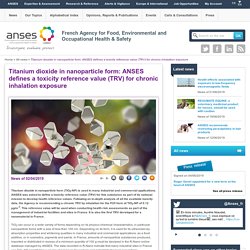
ANSES was asked to define a toxicity reference value (TRV) for this substance as part of its national mission to develop health reference values. Following an in-depth analysis of all the available toxicity data, the Agency is recommending a chronic TRV by inhalation for the P25 form of TiO2-NP of 0.12 µg/m-3. This reference value will be used when conducting health risk assessments as part of the management of industrial facilities and sites in France. TiO2 can occur in a wide variety of forms depending on its physico-chemical characteristics, in particular nanoparticle forms with a size of less than 100 nm.
In order to address the challenges of managing industrial facilities and sites in France, ANSES was asked to define a chronic TRV by inhalation for TiO2-NP (respiratory exposure). (PDF) Toxicity of Food-Grade TiO2 to Commensal Intestinal ... Clh comments titanium dioxide en. Food-grade TiO2 impairs intestinal and systemic immune ... Titanium dioxide, which is manufactured as a food ingredient (and referred to as E171), is ingested daily as mixed nano- and submicron-sized particles in the human diet1.
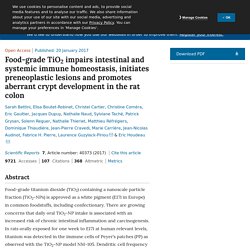
While recent reports based on NP models show that TiO2-NPs translocate through the intestinal epithelia, no in vivo study has been carried out to investigate the tissue distribution of food-grade TiO2 particles along the gut and whether the nanoscale fraction of E171 particles presents a specific risk via the oral route. Our study shows that ultrasonicated E171 particles prepared in water before oral administration to rats did not reagglomerate in vivo in the intestinal lumen. Transepithelial passage occurred in the jejunum and the colon after one week of treatment, and the titanium (Ti) reached the liver, exhibiting systemic absorption of E171 as previously reported based on TiO2-NP models13,14,26,27.
Marie Dorier , Impact du colorant alimentaire E171 et de nanoparticules de dioxyde de titane sur des modèles cellulaires, in vitro, d'épithélium intestinal. Les particules de dioxyde de titane (TiO2) sont utilisées dans de nombreux secteurs industriels du fait de leurs propriétés physiques et chimiques intéressantes.
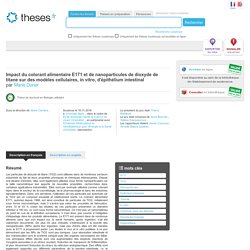
Depuis une dizaine d’années, elles sont également utilisées sous forme nanoparticulaire car la taille nanométrique leur apporte de nouvelles propriétés, recherchées dans certaines applications industrielles. Titanium Dioxide Nanoparticles in Food and Personal Care Products. Titanium Dioxide as Food Additive. 1. Introduction Titanium dioxide (TiO2) is a transition metal oxide with two main applications as either pigment or photocatalyst, in many sectors including buildings (self-cleaning windows, cements, paints and anti-fouling paints), paper industry, cosmetics (sunscreens and tooth paste), pharmaceutics (tablets), food (colouring agent) and others (air-purification system, rubbers, inks and ceramics).
Pigmentary applications are by far the most important application of TiO2. The interest in TiO2 lies in the scattering of visible light controlled by its high refractive index and its granulometry (size and shape). These requirements also apply for food where TiO2 provides a whitening effect. 2. Titanium dioxide is a food additive without any nutritive value and added in processed foods to provide a whitening effect. 2.1. 10.1007/s12011 019 01706 6. Thèses. L’´edition de revues scientifiques : une forme de marchandisation de la diffusion des connaissances. Colorant E171 - Les médicaments aussi ! Le dioxyde de titane nanométrique : aussi dangereux que l'amiante ?
Alexandre Imbert rédigé le 15 avril 2014 à 17h14 Vous serez tenu informé des articles paraissant sur ce sujet Fermer Notification Pour ajouter cet article à vos favoris, veuillez vous connecter.
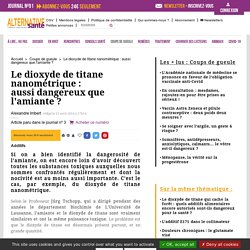
Dioxyde de titane: après avoir reçu les associations, Le ... Selon plusieurs associations de défense de l'environnement et de la santé publique, Bercy se serait engagé à suspendre à la mi-avril cet additif controversé très utilisé dans les bonbons. Plusieurs associations de défense de l'environnement et de la santé publique ont affirmé vendredi avoir obtenu du ministre de l'Économie Bruno Le Maire l'engagement de suspendre, à la mi-avril, l'utilisation du dioxyde de titane (TiO2) comme additif alimentaire. Dans l'émission «C à vous» sur France 5 mardi, Bruno Le Maire avait dit ne pas vouloir signer d'arrêté de suspension dans l'immédiat, mettant en avant des «évaluations différentes» sur la dangerosité potentielle du produit.
Après avoir reçu les associations vendredi, il «leur a réaffirmé sa volonté d'interdire l'E171, conformément à la position du gouvernement et aux dispositions votées par le Parlement dans l'article 53 de la loi Egalim» sur l'alimentation, selon un communiqué du ministère. Les confiseurs promettent des bonbons sans dioxyde de titane. BIOLA 2016 archivage. Dioxyde de titane de titane (E171) : Passons immédiatement à l’interdiction !
L’Agence nationale de sécurité sanitaire de l’alimentation, de l’environnement et du travail (Anses) vient de publier son avis sur le dioxyde de titane (E171), remis à Bruno Le Maire, appelant à l’application du principe de précaution et donc à une limitation de l’exposition des consommateurs vis-à-vis de cet additif.
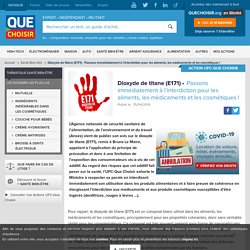
Au regard des risques que cet additif fait peser sur la santé, l’UFC-Que Choisir exhorte le Ministre à respecter sa parole en interdisant immédiatement son utilisation dans les produits alimentaires et à faire preuve de cohérence en élargissant l’interdiction aux médicaments et aux produits cosmétiques susceptibles d’être ingérés (dentifrices, rouges à lèvres …). Pour rappel, le dioxyde de titane (E171) est un composé blanc utilisé dans les aliments, les médicaments et les cosmétiques, principalement pour ses propriétés colorantes, donc sans véritable utilité pour les consommateurs. Evaluation of four new studies on the potential toxicity of titanium. Google Scholar. Un article de Wikipédia, l'encyclopédie libre. Google Scholar est un service de Google permettant la recherche d'articles et de publications scientifiques.
Lancé fin 2004, il inventorie des articles approuvés ou non par des comités de lecture (en anglais : peer-reviewed), des thèses de type universitaire, des citations ou encore des livres scientifiques. L'index de Google Scholar contient la plupart des journaux en ligne soumis à des comités de lecture, journaux provenant des grands éditeurs de littérature scientifique. Cependant la couverture réelle n’est pas connue précisément et plusieurs chercheurs ont repéré des trous dans sa couverture des archives des éditeurs.
En 2014, Google Scholar affirmait couvrir 85 % des publications scientifiques.